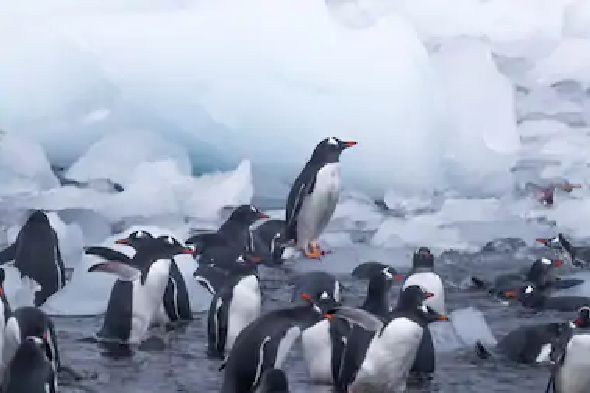365telugu.com,online news,New Delhi, july 4th 2020: The South Pole is warming more than three times faster than the rest of the world, research by Te Herenga Waka–Victoria University of Wellington experts shows.Their finding blows apart a general scientific consensus that the South Pole has been immune to warming, due to its entrenched extreme cold and its remoteness from drivers of global climate change.The increase in average temperatures at the pole seems to be linked to what’s going on in the tropics. School of Geography, Environment and Earth Sciences (SGEES) Postdoctoral Research Fellow Dr Kyle Clem says increased upward motion in the tropics appears to have strengthened cyclones in the South Atlantic Ocean and encouraged warm, moist air to travel further into the continental interior of Antarctica.Led by Dr Clem, the research team, which also includes SGEES Head Professor James Renwick, discovered the temperature at the South Pole has risen approximately 1.8 degrees Celsius (C) in the 30 years since 1989.Dr Clem says teasing out how much of that warming can be attributed to increasing greenhouse gas emissions is difficult. However, using the average from climate models that include increased greenhouse gases, it may be about 1degree C across those three decades.
“That’s compared to the 1.8C of warming observed and the dramatic cooling of more than 1C during the 1980s and 1990s. Therefore, decadal temperature fluctuations exceed the anthropogenic signal by a factor of three.“We also found climate models that did not have anthropogenic greenhouse gases were able to produce 30-year warming rates greater than the observed 1.8C, further demonstrating how extreme ‘natural’ temperature fluctuations are at the South Pole.”Their paper, Record warming at the South Pole during the past three decades has just been published in Nature Climate Change.Dr Clem says his interest in South Pole temperatures was piqued by work as one of the lead authors on the Antarctic section of the annual State of the Climate report for NOAA (National Oceanic and Atmospheric Administration). He began looking at data from weather stations across Antarctica, including one at the South Pole.“That is a year-round base and they have been taking routine observations since 1957. So it is one of the longest-running stations in Antarctica with continuous records. Their monthly temperature record is 100 percent complete since 1957, which is incredible.“I was looking at the anomalies at the different stations around Antarctica and saw that the South Pole was very warm in 2018 and it was 2.4C warmer than the 1981-2010 climatology, which we use as a standard base period.“I looked a bit closer and that was the warmest year ever recorded at the South Pole. And its neighbour in Antarctic terms—the Russian station Vostok up on the East Antarctic Plateau— was also 2.4C above its climatology and also had its warmest year on record dating back to 1958.“I proposed we do a special report on this, documenting what atmospheric circulation pattern may have led to this extreme warmth. I came out of that with a deep curiosity about putting these records into a longer-term context, and that is what inspired me to do this study.”Dr Clem says the researchers found the 0.61C plus or minus 0.34C per decade polar warming was the end result of a succession of events in the tropics.

“The warming resulted from a strong cyclonic anomaly in the Weddell Sea, caused by increasing sea-surface temperatures in the western tropical Pacific Ocean, which transferred warm and moist air from the South Atlantic into the Antarctic interior.This shows how intimately linked the climate ofAntarctica is to tropical variability. Our study also shows how atmospheric internal variability can induce extreme regional climate change throughout the Antarctic interior, which has masked any anthropogenic warming signal there during the twenty first century.In fact the South Pole over the past 30 years has warmed more than three times faster than the global average warming, while over the same period the warming on the Antarctic Peninsula and across West Antarctica stopped and even reversed.”While the observed warming is in large part linked to natural variability, humans have clearly also played their part, he says.Over the full range of all possible 30-year trends in climate models without anthropogenic greenhouse gases, the observed warming lies in the upper 0.1 percent, meaning it is extremely rare and that the recent warming was probably pushed to such an extreme level by anthropogenic forcing.Next we compared the observed warming to the highest 30-year trend in each of the 52 models without anthropogenic greenhouse gases, and found 10 percent of the models produced warming trends stronger than the one observed.However, comparing the observed warming trend to only the highest warming trends in each model is like comparing heights across NBA players.
“Just because LeBron James isn’t the tallest person in the NBA doesn’t mean he isn’t unusually tall. However, we can’t conclude definitely that his height is outside the range of natural height variations in humans.We also need to keep in mind that the 1C of warming estimated from greenhouse gases is possibly overestimated due to climate models poorly simulating Antarctic warming from increasing greenhouse gases.Many of today’s modern climate models that we use in our study have overestimated Antarctic sea-ice melting up to 2014 and therefore also tend to overestimate the Antarctic warming.”Next on the horizon for Dr Clem is further studying the impacts of the South Atlantic low-pressure anomaly on the surrounding sea ice and ice sheet.To the west of the Antarctic Peninsula in the South Pacific lies the stormiest region on Earth, called the Amundsen Sea Low. But what we found in our study is that cyclones have actually been strengthening east of the peninsula in the South Atlantic sector, which is puzzling.So while our study identified the likely cause of the strong cyclone and its impact on interior Antarctic temperature, what else has this unusual circulation done to the local sea ice and cryosphere, and will it continue in the future?”

